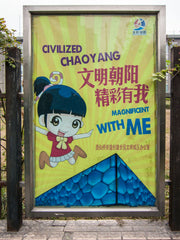About Chinese propaganda posters

Propaganda posters have been used in China as a means of mass communication since the founding of the People's Republic of China (PRC) in 1949. Posters had been used to disseminate information on the correct manners of behaving and thinking since much earlier, but it was under the control of the Chinese Communist Party that the use of the poster as a major way of influencing public behaviour was first undertaken. The principles of communist art had been set out in the 1942 Yan'an Forum on Literature and Art: its purpose was to serve politics and the masses. There was to be no art for art's sake.
During the 1940s and 1950s a large proportion of China's population was illiterate, and the poster was regarded as the ideal vehicle for delivering a message in a concise and simple to understand way - even if the slogan could not be read. They were cheap, easy to produce by the hundreds of thousands, and could be displayed in the home, workplace and in the street. The idea was to provide a model of correct behaviour which would be in turn followed by the people, whether consciously or otherwise. Generations of children would spend their entire childhoods absorbing the messages on the attractive, brightly coloured designs that would often be displayed to brighten up the walls of their homes.
The posters accompany and illustrate every major political and social event in the history of the PRC, from the construction of the new People's Republic, the Great Leap Forward of 1958-61, the decade of Cultural Revolution in the 1960s and 1970s up to the reform and modernisation period beginning in the late 1970s. Many would learn to read subtexts from the posters' content - the omission of a certain person at a certain time, for example, could signify the falling from grace of a prominent party member.
The design of the posters was influenced mainly by Soviet Socialist Realism. In the 1950s many Chinese artists were sent to train in the Soviet Union; soviet tutors also came to China during this period to teach. The styles were adapted over the years, to better represent China's own particular brand of socialism. The posters can be broadly categorised into three groups: nianhua (new year or popular prints), xuanchuanhua (propaganda posters) and huapian (reproductions of paintings). The brightly coloured nianhua were often pasted on to doors to welcome in the new year; these popular traditional designs incorporating folk art and symbolism were adapted in the PRC to include more revolutionary messages. Xuanchuanhua were usually painted in gouache, contained a slogan, and were rapidly produced on-demand to illustrate the quickly changing political events of the time. Huapian were often reproductions of ink or oil paintings (not originally intended as posters) that were popular decorations in the home and available all year round - one very well known example, Chairman Mao goes to Anyuan, is said to have been reproduced 900 million times.
 As China opened up to the outside world in the 1980s, the use of the poster by the state to transmit information began its decline, overtaken by modern advertising and billboards. The public had begun to view them as old-fashioned, and allegedly a great proportion were recalled by the state and sent for recycling. Countless more were disposed of throughout the 80s and 90s. This means that despite the huge numbers that propaganda posters were produced in, they remain relatively rare today. Today posters are making something of a comeback however, with many to be seen in modern streets (see image) promoting correct behaviour, the party, and the new China.
As China opened up to the outside world in the 1980s, the use of the poster by the state to transmit information began its decline, overtaken by modern advertising and billboards. The public had begun to view them as old-fashioned, and allegedly a great proportion were recalled by the state and sent for recycling. Countless more were disposed of throughout the 80s and 90s. This means that despite the huge numbers that propaganda posters were produced in, they remain relatively rare today. Today posters are making something of a comeback however, with many to be seen in modern streets (see image) promoting correct behaviour, the party, and the new China.
A note on translations: all the translations of titles and publishing information on the posters are our own. We've done our best to stick with the original meanings and to be concise - which can be challenging with certain titles. The written Chinese language often allows for abbreviation which may be understood in context but is a challenge to translate meaningfully and concisely. Titles also sometimes refer to short-lived contemporary political campaigns that aren't well known outside China. You may see other translations of the same poster titles that differ from ours - hopefully we've conveyed the intended meaning as well as others have.
On certain posters individual artists are not credited and there is only a collective group name given. In these cases we have directly translated the information provided.
